Optimisation on the Performance of Bubble-Bursting Atomisation for Minimum Quantity Lubrication with Vegetable Oil Using Computational Fluid Dynamics Simulation
Abstract
:1. Introduction
2. Materials and Methods
| Type of Fluids | Density (kg/m3) | Viscosity (kg/(ms)) |
|---|---|---|
| air | 1.225 | 1.7894 × 10−5 |
| vegetable oil | 910 | 0.035 |
| Zone | Properties |
|---|---|
| outlet | pressure outlet |
| wall | stationary wall, no slip |
| Scheme | SIMPLE |
| Gradient | Least-squares-cell-based |
| Pressure | PRESTO! |
| Momentum | Second-order upwind |
| Volume fraction | Geo-reconstruct |
| Turbulent kinetic energy | First-order upwind |
| Turbulent dissipation rate | First-order upwind |
| Transient formulation | First-order implicit |
| Simulation No. | Air Inlet Velocity (ms−1) | Air Inlet_2 Velocity (ms−1) | Distance of Gap between Air Inlets (mm) |
|---|---|---|---|
| 1 | 1.0 | 1.0 | 15 |
| 2 | 0.1 | 0.1 | 15 |
| 3 | 0.1 | 1.0 | 15 |
| 4 | 0.1 | 10.0 | 15 |
| 5 | 0.1 | 10.0 | 50 |
3. Results and Discussion
4. Conclusions
Author Contributions
Funding
Acknowledgments
Conflicts of Interest
References
- Global Machine Tools Market Size, Share & Industry Trends Analysis Report by Type, by Technology, by Sales Channel, by End-Use, by Regional Outlook and Forecast, 2021–2027; ReportLinker: Lyon, France, 2022.
- Khan, M.; Dhar, N. Performance evaluation of minimum quantity lubrication by vegetable oil in terms of cutting force, cutting zone temperature, tool wear, job dimension and surface finish in turning AISI-1060 steel. J. Zhejiang Univ. Sci. A 2006, 7, 1790–1799. [Google Scholar] [CrossRef]
- Klocke, F.; Eisenblaetter, G. Dry cutting. CIRP Ann. 1997, 46, 519–526. [Google Scholar] [CrossRef]
- Wang, X.; Li, C.; Zhang, Y.; Ding, W.; Yang, M.; Gao, T.; Cao, H.; Xu, X.; Wang, D.; Said, Z.; et al. Vegetable oil-based nanofluid minimum quantity lubrication turning: Academic review and perspectives. J. Manuf. Processes 2020, 59, 76–97. [Google Scholar] [CrossRef]
- Gupta, M.; Boy, M.; Korkmaz, M.; Yasar, N.; Guenay, M.; Krolczyk, G. Measurement and analysis of machining induced tribological characteristics in dual jet minimum quantity lubrication assisted turning of duplex stainless steel. Measurement 2022, 187, 110353. [Google Scholar] [CrossRef]
- Sun, H.; Zou, B.; Chen, P.; Huang, C.; Guo, G.; Liu, J.; Li, L.; Shi, Z. Effect of MQL condition on cutting performance of high-speed machinng of GH4099 with ceramic end mills. Tribol. Int. 2022, 167, 107401. [Google Scholar] [CrossRef]
- Chakravarthy, V.; Thiagarajan, R.; Dharanendran, V.; Palanikumar, K. Sustainable Drilling of Nano SiC Reinforced Al Matrix Composites Using MQL and Cryogenic Cooling for Achieving the Better Surface Integrity. Silicon 2021, 14, 1787–1805. [Google Scholar] [CrossRef]
- Das, A.; Das, S.; Patel, S.; Biswal, B. Effect of MQL and nanofluid on the machinability aspects of hardened alloy steel. Mach. Sci. Technol. 2019, 24, 291–320. [Google Scholar] [CrossRef]
- Gunan, F.; Kivak, T.; Yildirim, C.; Sarikaya, M. Performance evaluation of MQL with AL2O3 mixed nanofluids prepared at different concentrations in milling of Hastelloy C276 alloy. J. Mater. Res. Technol. 2020, 9, 10386–10400. [Google Scholar] [CrossRef]
- Gupta, A.; Kumar, R.; Kumar, H.; Garg, H. Sustainable machining using hybrid nanofluids under minimum quantity lubrication (MQL). In Advances in Industrial and Production Engineering; Lecture Notes in Mecfhanical Engineering; Springer: Singapore, 2019; pp. 573–584. [Google Scholar] [CrossRef]
- Hamran, N.; Ghani, J.; Ramli, R.; Haron, C. A review on recent development of minimum quantity lubrication for sustainable machining. J. Clean. Prod. 2020, 268, 122165. [Google Scholar] [CrossRef]
- Haq, M.; Hussain, S.; Ali, M.; Farooq, M.; Mufti, N.; Pruncu, C.; Wasim, A. Evaluating the effects of nano-fluids based MQL milling of IN718 associated to sustainable productions. J. Clean. Prod. 2021, 310, 127463. [Google Scholar] [CrossRef]
- Javid, H.; Jahanzaib, M.; Jawad, M.; Ali, M.; Farooq, M.; Pruncu, C.; Hussain, S. Parametric analysis of turning HSLA steel under minimum quantity lubrication (MQL) and nanofluids-based minimum quantity lubrication (NF-MQL): A concept of one-step sustainable machining. Int. J. Adv. Manuf. Technol. 2021, 117, 1915–1934. [Google Scholar] [CrossRef]
- Korkmaz, M.; Gupta, M.; Boy, M.; Yasar, N.; Krolczyk, G.; Guenay, M. Influence of duplex jets MQL and nano-MQL cooling system on machining performance of Nimonic 80A. J. Manuf. Processes 2021, 69, 112–124. [Google Scholar] [CrossRef]
- Makhesana, M.; Patel, K.; Khanna, N. Analysis of vegetable oil-based nano-lubricant technique for improving machinability of Inconel 690. J. Manuf. Processes 2022, 77, 708–721. [Google Scholar] [CrossRef]
- Pervaiz, S.; Anwar, S.; Qureshi, I.; Ahmed, N. Recent advances in the machining of titanium alloys using Minimum Quantity Lubrication (MQL) based techniques. Int. J. Precis. Eng. Manuf. Green Technol. 2019, 6, 133–145. [Google Scholar] [CrossRef]
- Yuecel, A.; Yildirim, C.; Sarikaya, M.; Sirin, S.; Kivak, T.; Gupta, M.; Tomaz, I. Influence of MoS2 based nanofluid-MQL on tribological and machining characteristics in turning of AA 2024 T3 aluminium alloy. J. Mater. Res. Technol. 2021, 15, 1688–1704. [Google Scholar] [CrossRef]
- Zakaria, M.; Suhaimi, M.; Sharif, S.; Yang, D.; Shaharum, M.; Kamal, M.; Zakaria, K. The application of cold air and nano- MQL as cooling strategy in high speed milling of titanium alloy Ti-6Al-4V: A review. In AIP Conference Proceedings; AIP Publishing LLC: Melville, NY, USA, 2019; p. 2129. [Google Scholar] [CrossRef]
- Kasim, M.; Haron, C.; Ghani, J.; Gusri, A.; Yazid, M.; Sulaiman, M. Tool life of TiAlN PVD coated carbide tool in high-speed end milling of untreated Inconel 718 under minimum quantity lubrication condition. Sains Malays. 2013, 42, 1721–1726. [Google Scholar]
- Sayuti, M.; Sarhan, A.; Hamdi, M. An investigation of optimum SiO2 nanolubrication parameters in end milling of aerospace Al6061-T6 alloy. Int. J. Adv. Manuf. Technol. 2013, 67, 833–849. [Google Scholar] [CrossRef]
- Dambatta, Y.; Sayuti, M.; Sarhan, A.; Hamdi, M. Comparative study on the performance of the MQL nanolubricant and conventional flood lubrication techniques during grinding of Si3N4 ceramic. Int. J. Adv. Manuf. Technol. 2018, 96, 3959–3976. [Google Scholar] [CrossRef]
- Sulaiman, M.; Haron, C.; Ghani, J.; Kasim, M. Effect of high-speed parameters on uncoated carbide tool in finish turning titanium Ti-6Al-4V ELI. Sains Malays. 2014, 43, 111–116. [Google Scholar]
- Ishak, A.; Ghani, J.; Haron, C. Penentuan faktor yang mempengaruhi daya dan taburan tegasan semasa pemesinan besi tuangan mulur (FCD 500) secara simulasi. Sains Malays. 2012, 41, 1605–1612. [Google Scholar]
- Ghani, J.; Hanif, M. Kesan parameter pemesinan ke atas pembentukan serpihan semasa mengisar hujung keluli terkeras aisi H 13 menggunakan mata alat sermet. J. Kejuruter. 2004, 16, 27–34. [Google Scholar]
- Aitken, R.; Creely, K.; Tran, C. Nanoparticles: An Occupational Hygiene Review; HSE Books: London, UK, 2004. [Google Scholar]
- Pilacinski, W.; Pan, M.; Szewczyk, K.; Lehtimaki, M.; Willeke, K. Aerosol Release from Aerated Broths. Biotechnol. Bioeng. 1990, 36, 970–973. [Google Scholar] [CrossRef] [PubMed]
- Radomski, A.; Jurasz, P.; Alonso-Escolano, D.; Drews, M.; Morandi, M. Nanoparticle-induced platelet aggregation and vascular thrombosis. Br. J. Pharmacol. 2005, 146, 882–893. [Google Scholar] [CrossRef] [PubMed] [Green Version]
- Yu, X.; Gu, H.; Yin, W.; Sun, Q.; Zhou, Y. Experimental research on droplets releasing characteristics of the bubble bursting behavior at a free surface with an aerosol. Ann. Nucl. Energy 2022, 173, 109109. [Google Scholar] [CrossRef]
- Chen, H.; Gu, H.; Lv, H.; Yu, X.; Wang, J.; Luo, H. Experimental study on the release of droplets via bubble bursting under different liquid phase conditions. Prog. Nucl. Energy 2021, 132, 103617. [Google Scholar] [CrossRef]
- Lv, C.; Tsona, N.; Du, L. Sea spray aerosol formation: Results on the role of different parameters and organic concentrations from bubble bursting experiments. Chemosphere 2020, 252, 126456. [Google Scholar] [CrossRef]
- Blanchard, D. The ejection of drops from the sea and their enrichment with bacteria and other materials: A review. Estuaries 1989, 12, 127–137. [Google Scholar] [CrossRef]
- Blanchard, D.; Woodcock, A. Bubble formation and modification in the sea and its meteorological significance. Tellus 1957, 9, 145–158. [Google Scholar] [CrossRef]
- Leifer, I.; de Leeuw, G. Bubbles generated from wind-steepened breaking waves: 1. Bubble plume bubbles. J. Geophys. Res. 2006, 111, C06020. [Google Scholar] [CrossRef] [Green Version]
- Feng, J.; Roche, M.; Vigolo, D.; Arnaudov, L.; Stoyanov, S.; Gurkov, T.; Tsutsumanova, G.; Stone, H. Nanoemulsions obtained via bubble bursting at a compound interface. Nat. Phys. 2014, 10, 606–612. [Google Scholar] [CrossRef] [Green Version]
- Spiel, D. On the births of film drops from bubbles bursting on seawater surfaces. J. Geophys. Res. 1998, 103, 24907–24918. [Google Scholar] [CrossRef]
- Cipriano, R.; Blanchard, D. Bubble and aerosol spectra produced by a laboratory ‘Breaking Wave’. J. Geophys. Res. 1981, 86, 8085–8092. [Google Scholar] [CrossRef]
- Li, Z.; Yuan, Y.; Guo, B.; Varsegov, V.; Yao, J. The recirculation zone characteristics of the circular transverse jet in crossflow. Energies 2020, 13, 3224. [Google Scholar] [CrossRef]
- Randall, M. Consolidation Techniques. In Comprehensive Hard Materials; Elsevier: Oxford, UK; Waltham, MA, USA, 2014; Volume 1. [Google Scholar]
- Nath, C.; Kapoor, S.; DeVor, R.; Srivastava, A.; Iverson, J. Design and evaluation of an atomization-based cutting fluid spray system in turning of titanium alloy. J. Manuf. Processes 2012, 14, 452–459. [Google Scholar] [CrossRef]
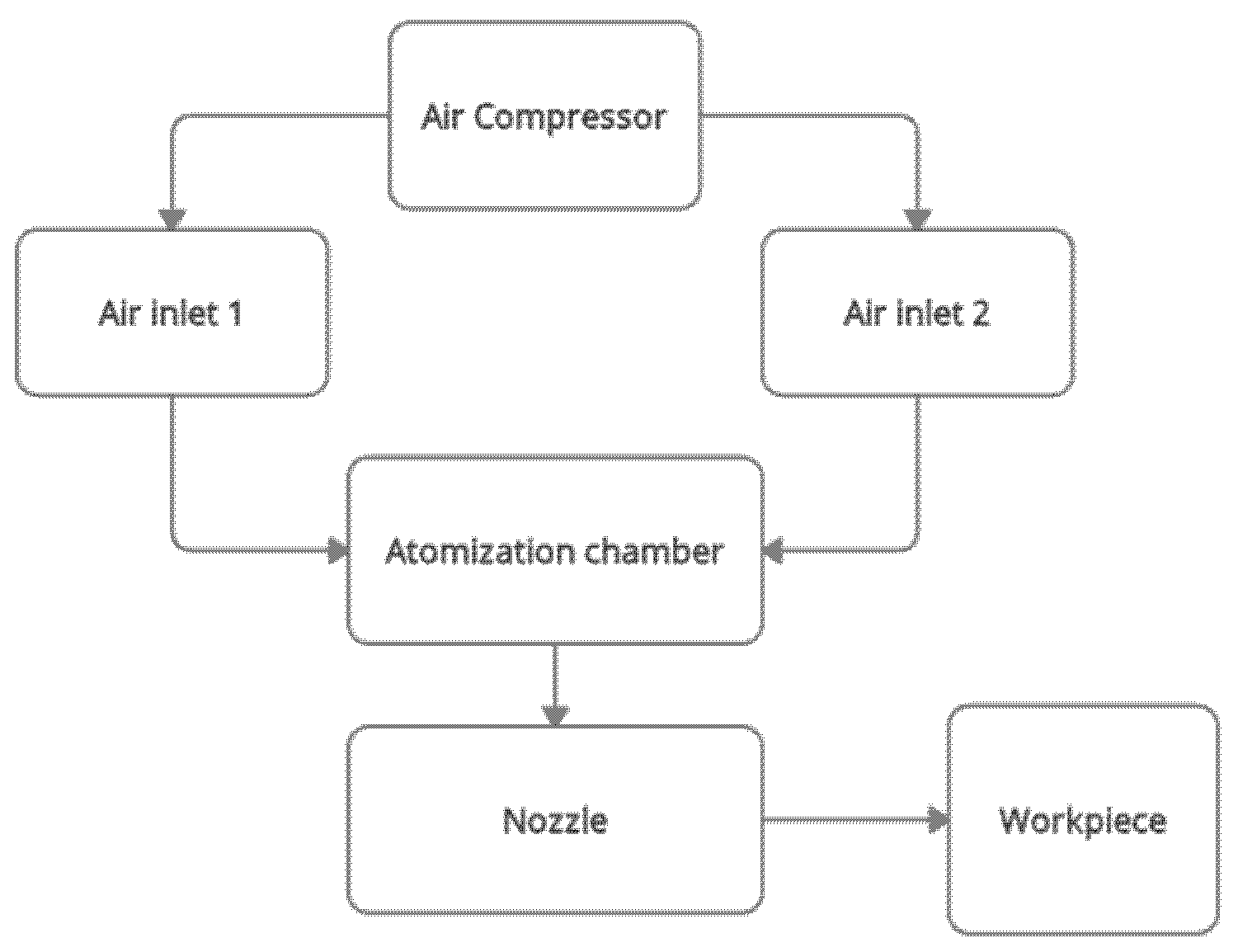
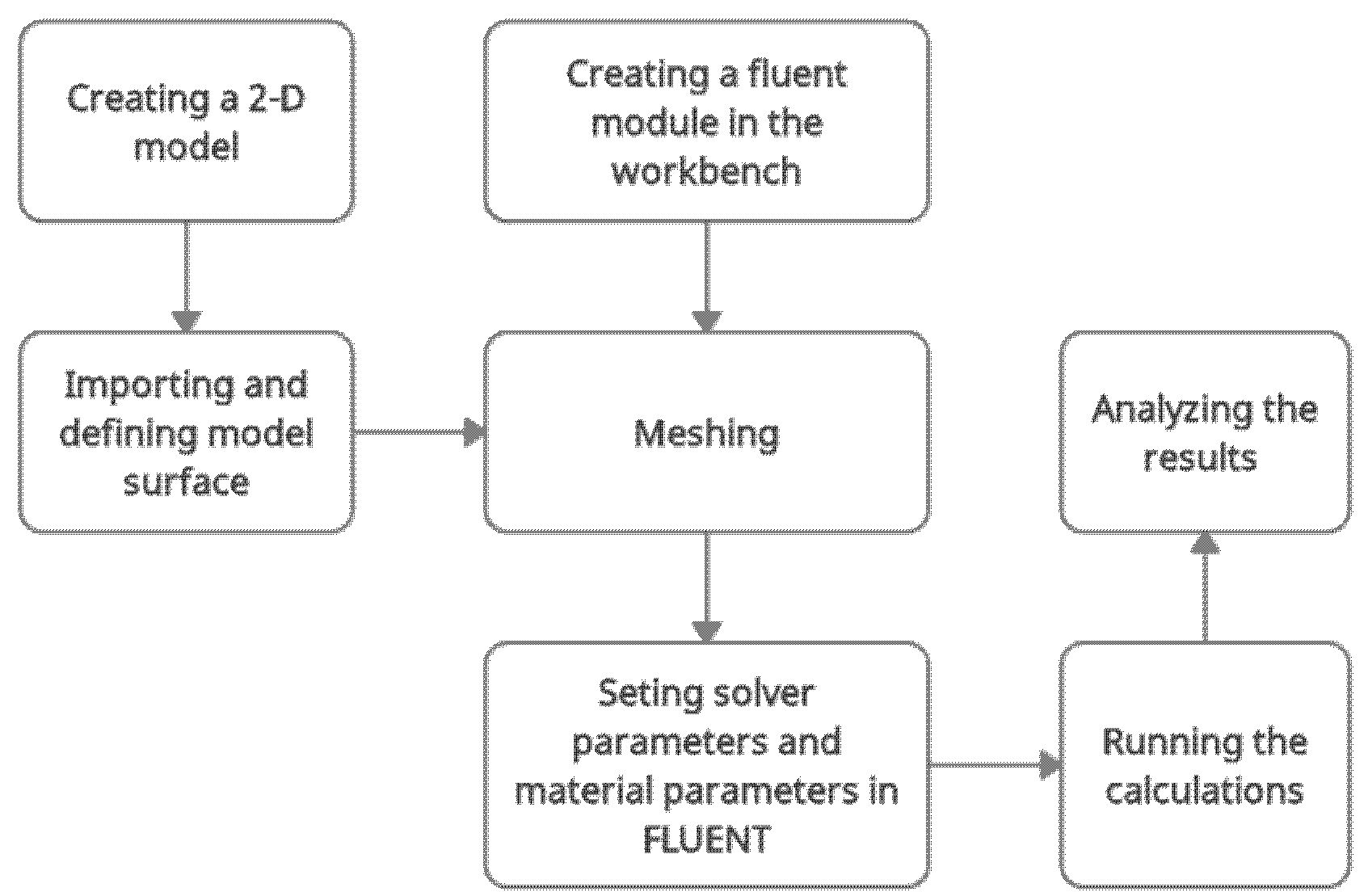
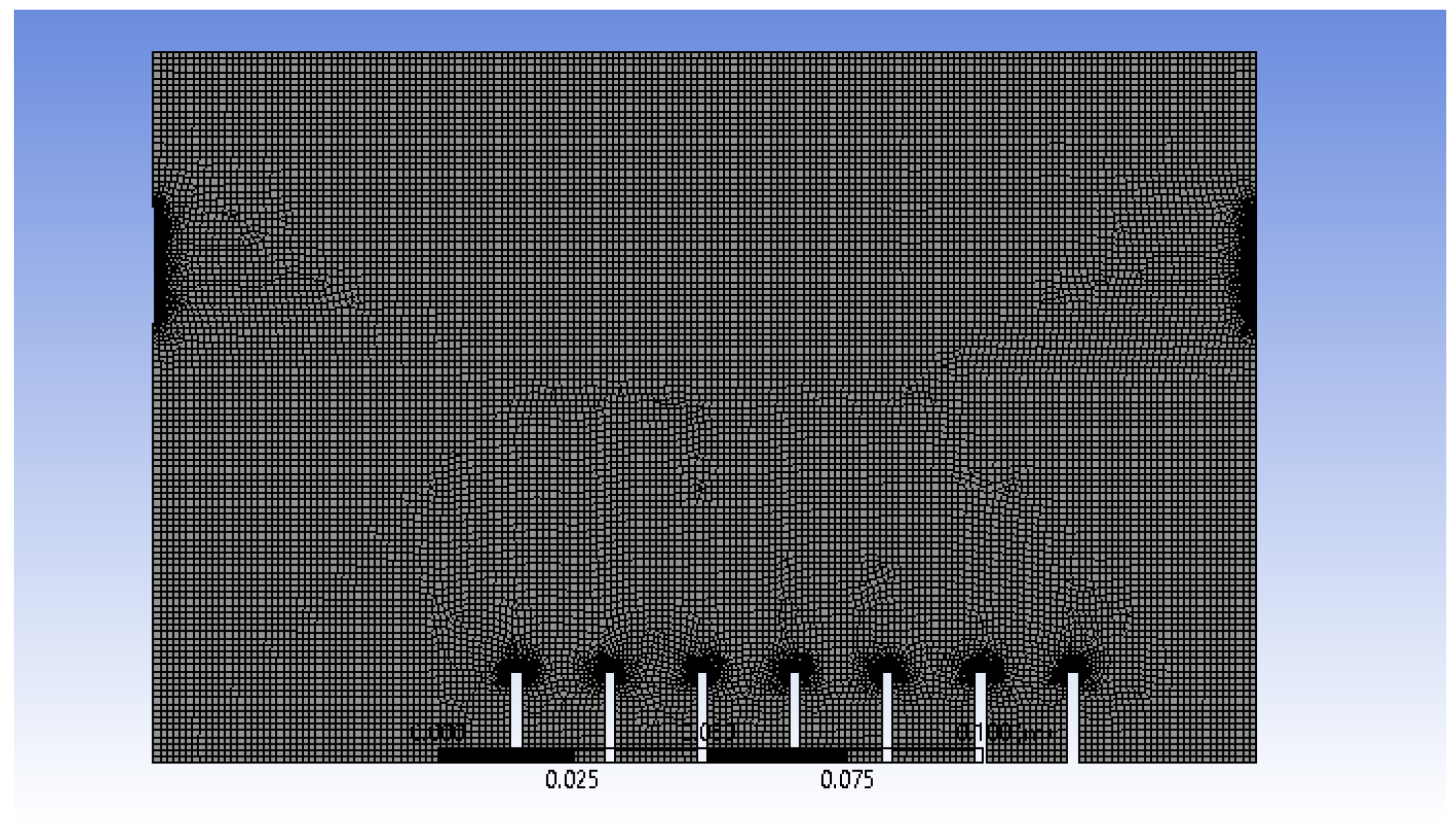
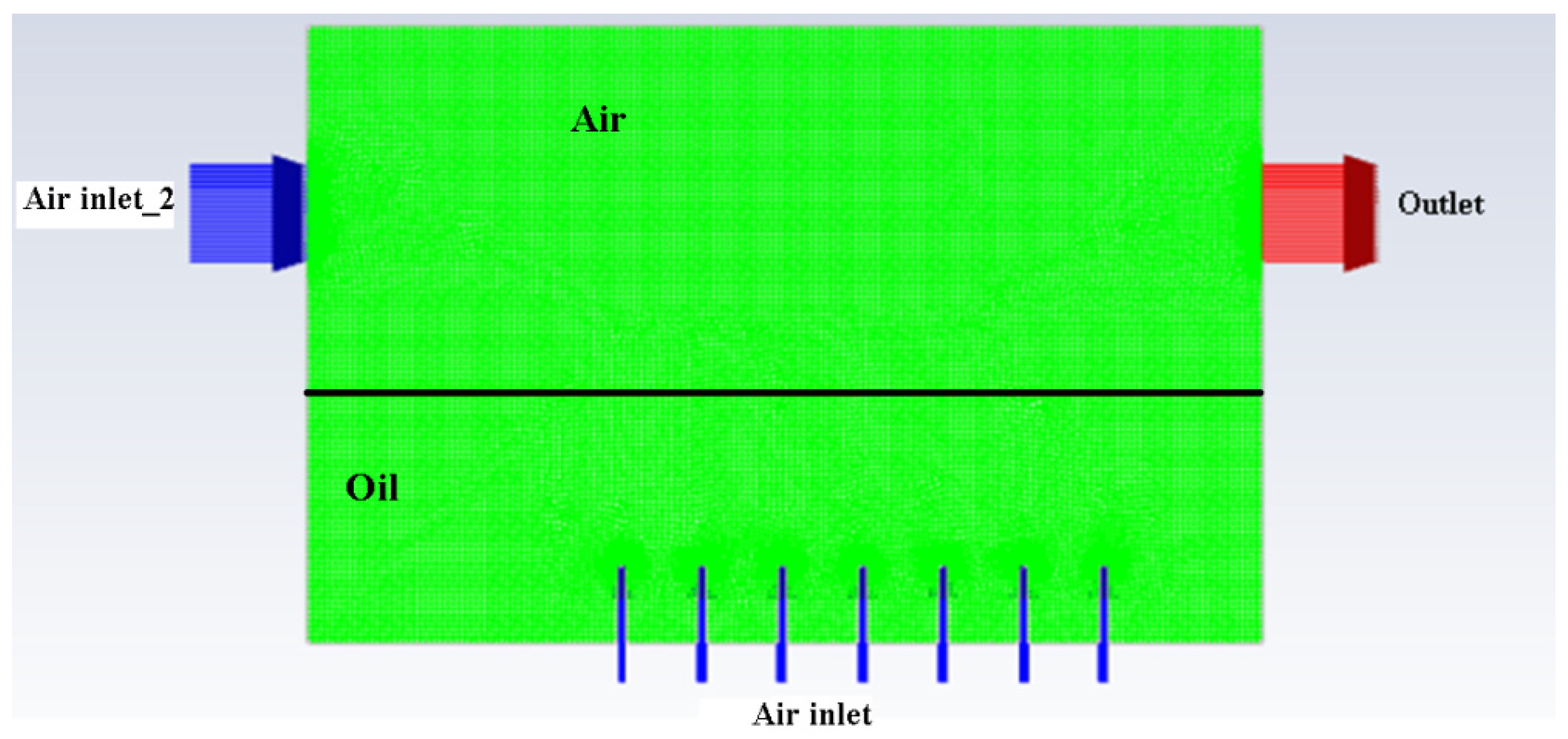
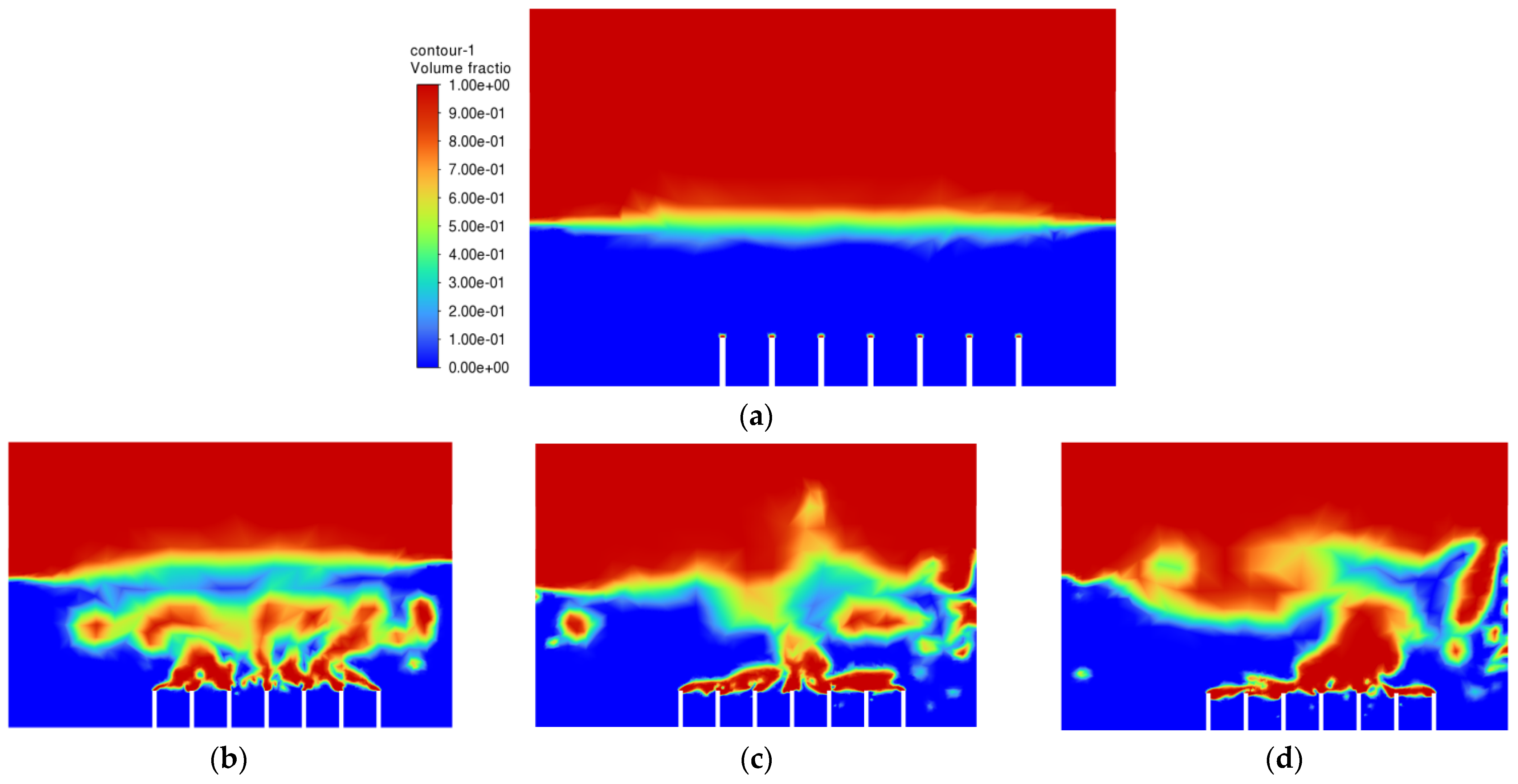


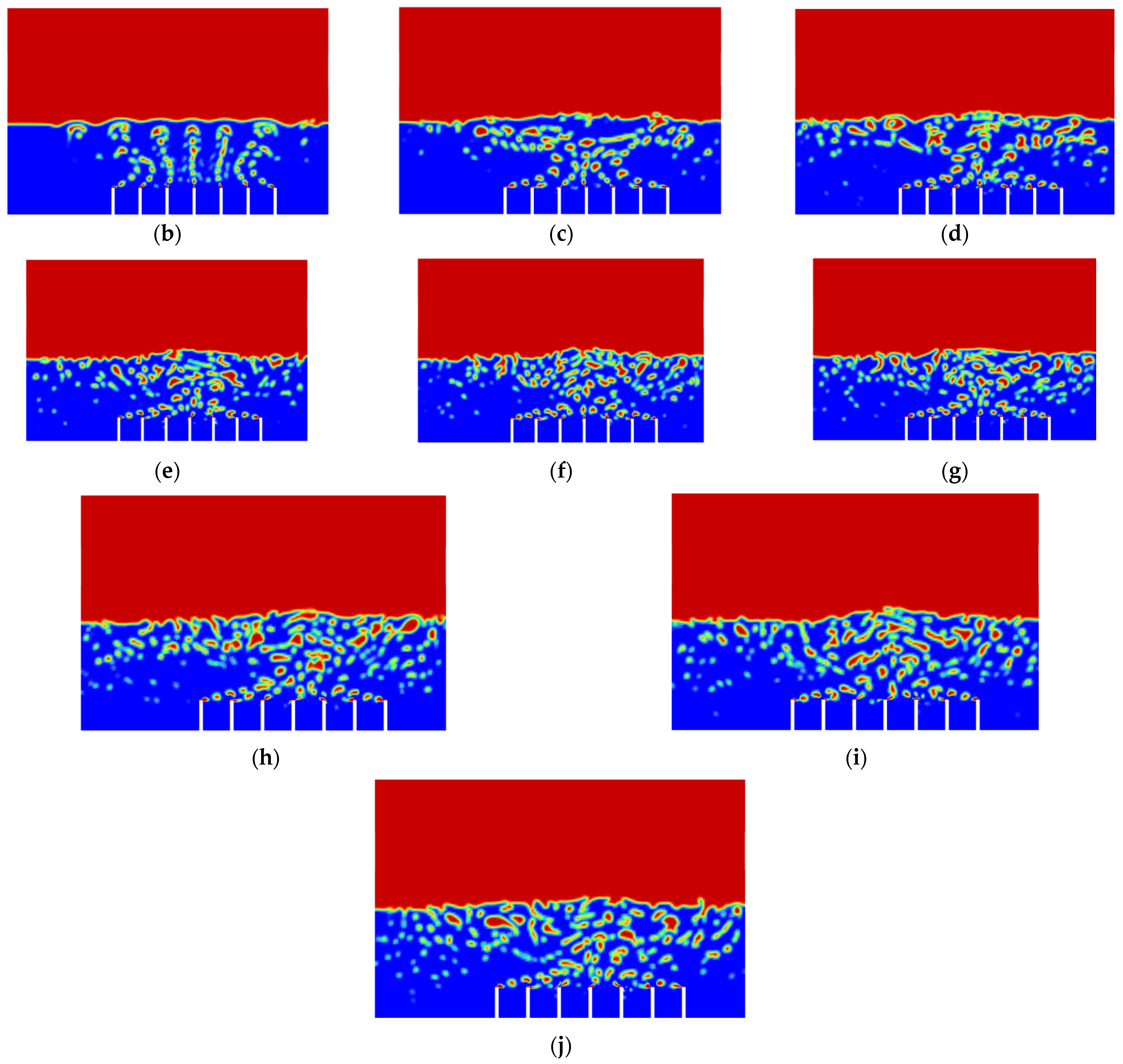

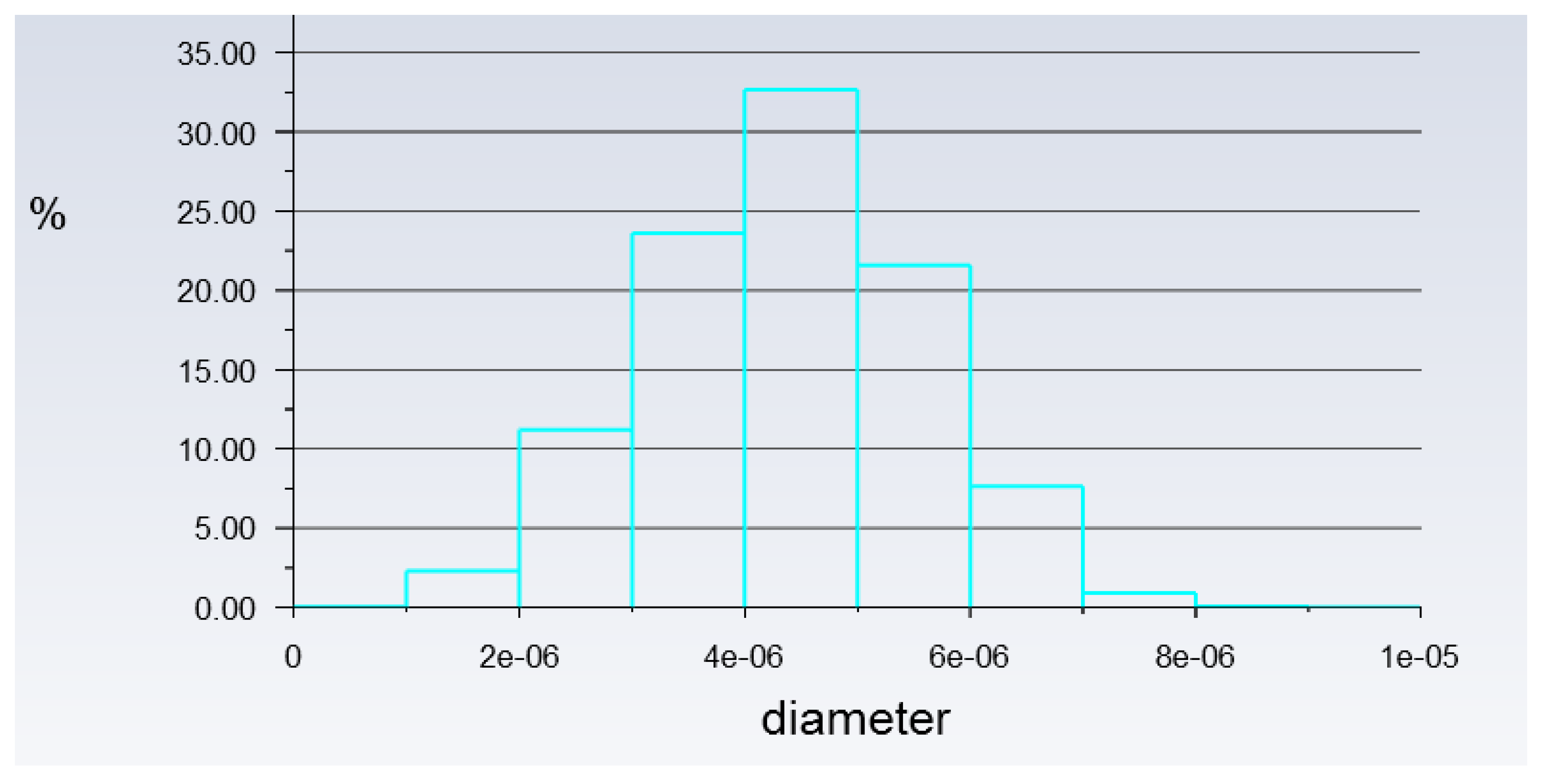
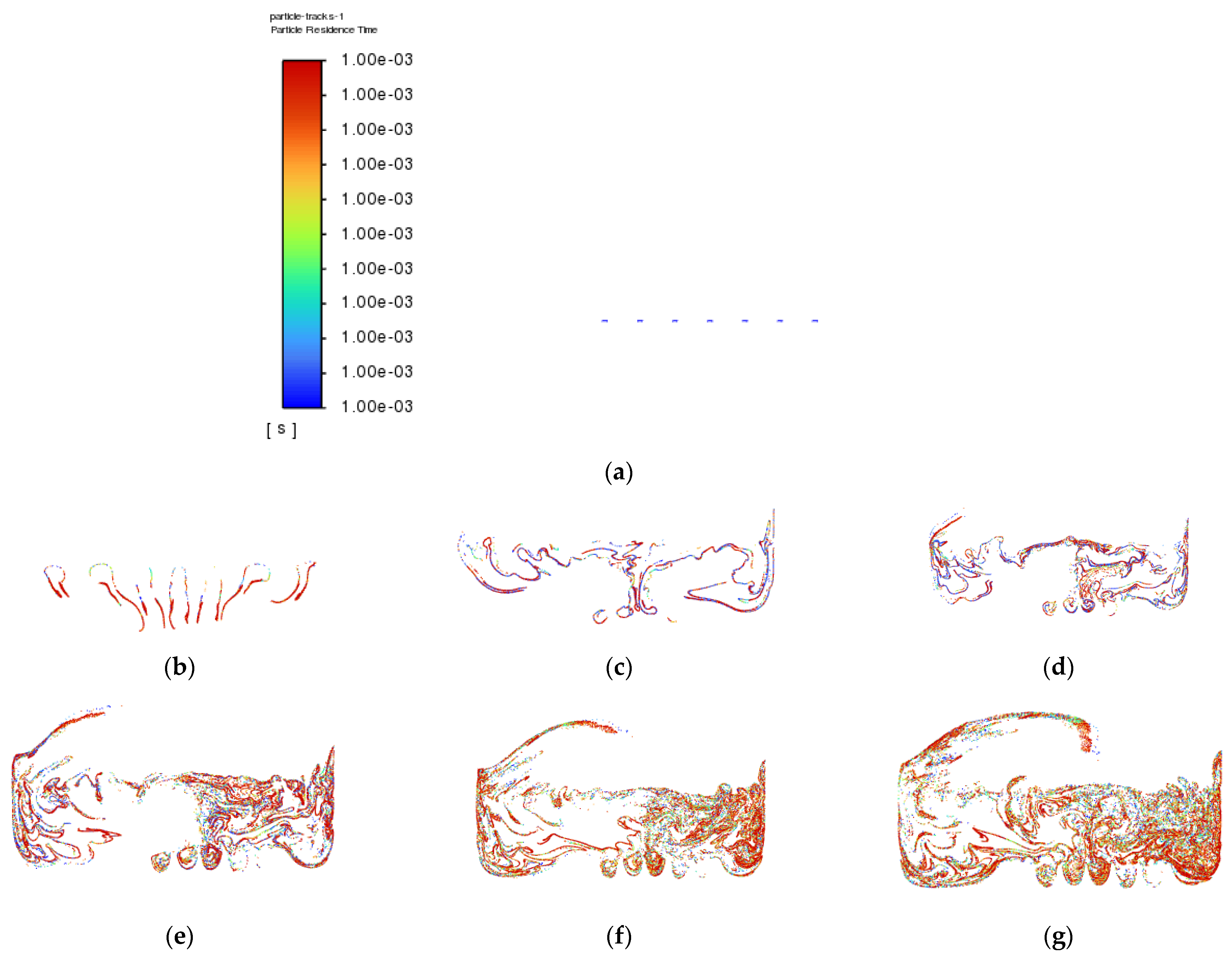


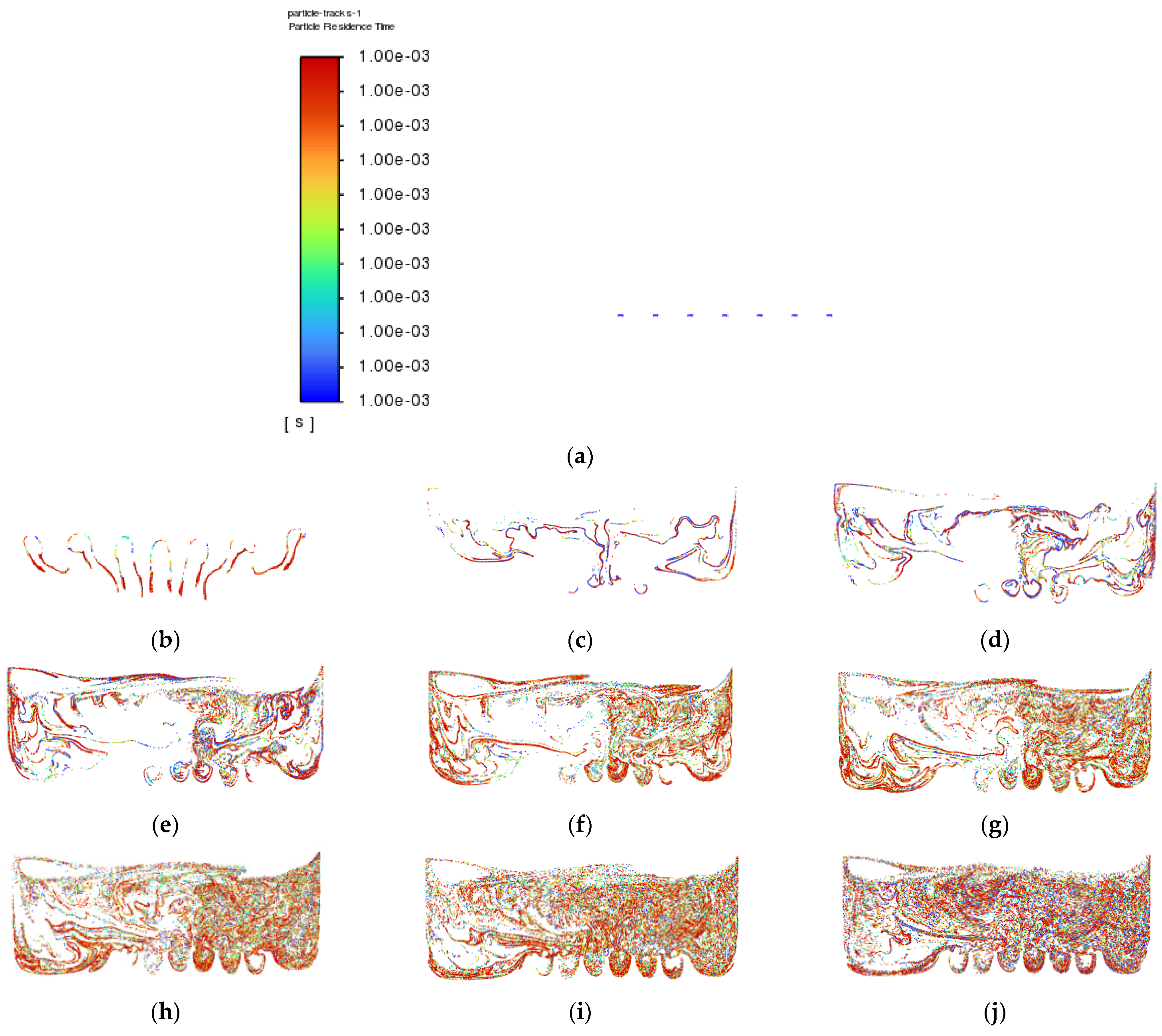
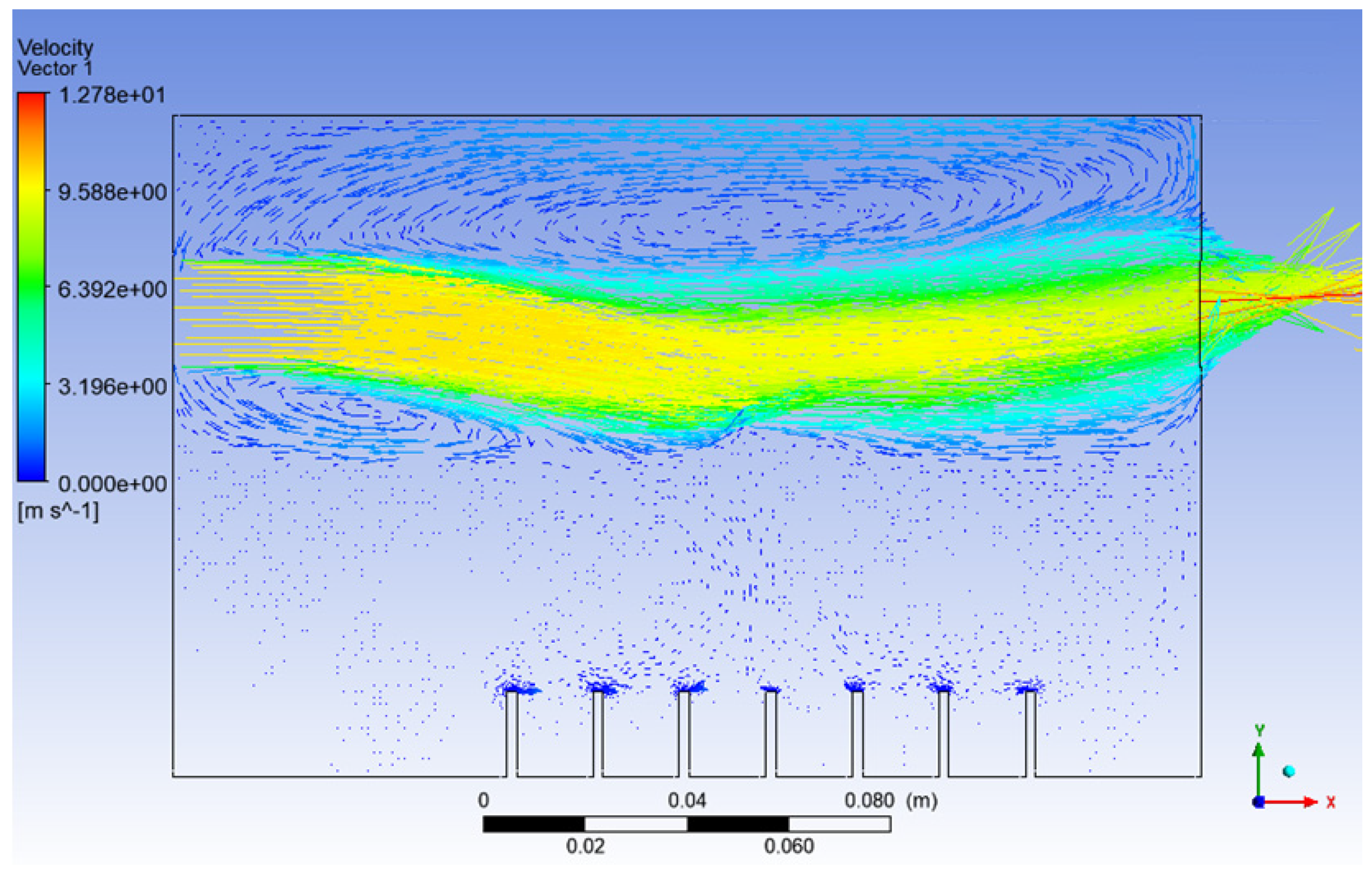

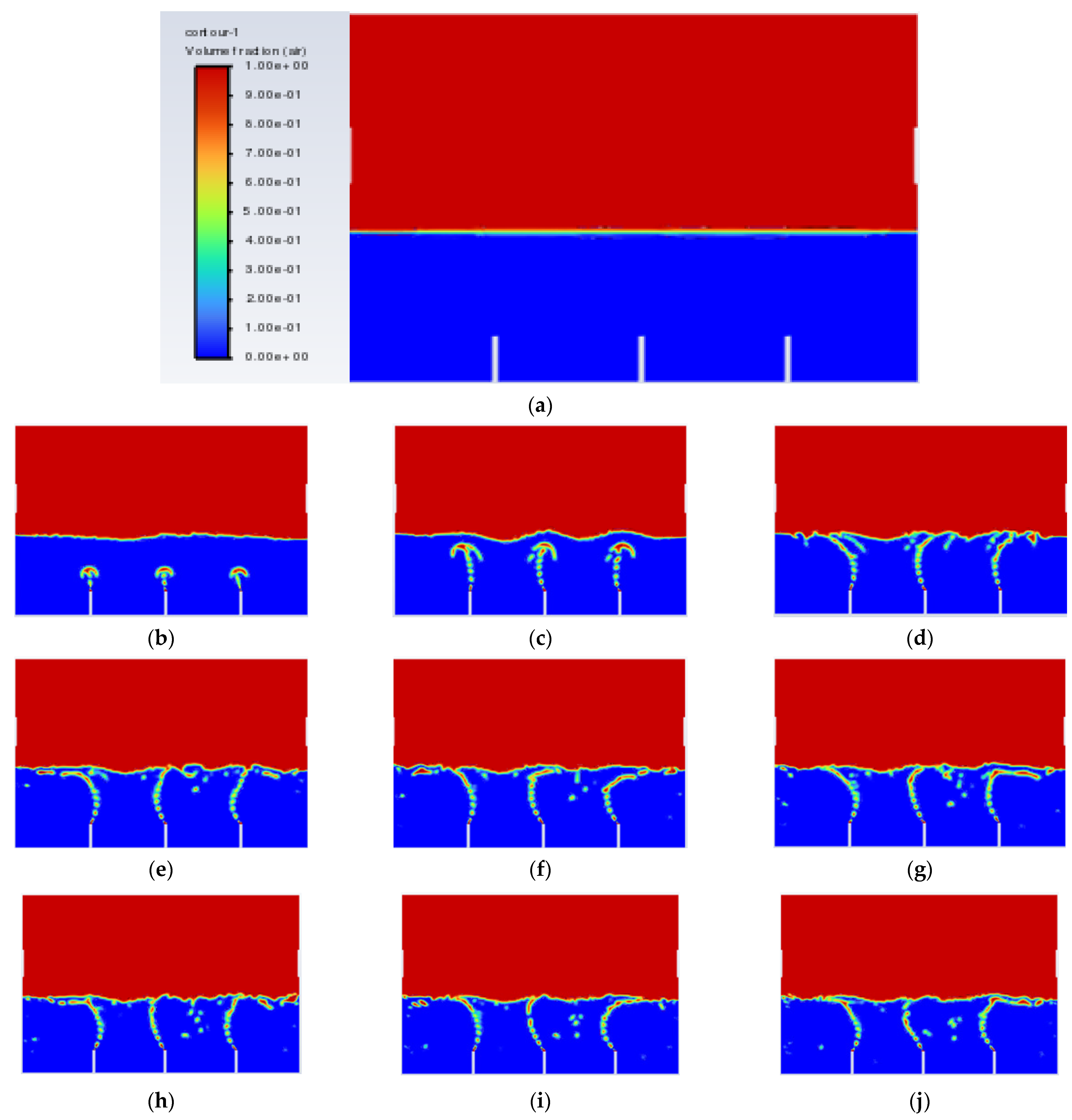
| Element Size | 1.2 × 10−3 m |
| Edge Sizing 1 | Edges selected: air inlets and outlets |
| Number of divisions: 100 | |
| Edge Sizing 2 | Edges selected: Wall |
| Number of divisions: 50 | |
| Face meshing | Triangle: best split |
| Type | Pressure-based |
| Time | Transient |
| Gravity | −9.81 ms−1 (y-direction) |
| Model | Volume of fluid (VOF) |
| Formulation | Explicit |
| Body force formulation | Implicit body force |
| Number of Eulerian phases | 2 |
| Viscous | k-epsilon (2 eqn) |
| k-epsilon model | Realizable |
| Near-wall treatment | Enhanced wall treatment |
Publisher’s Note: MDPI stays neutral with regard to jurisdictional claims in published maps and institutional affiliations. |
© 2022 by the authors. Licensee MDPI, Basel, Switzerland. This article is an open access article distributed under the terms and conditions of the Creative Commons Attribution (CC BY) license (https://creativecommons.org/licenses/by/4.0/).
Share and Cite
Yap, P.H.; Ghani, J.A.; Wan Mahmood, W.M.F. Optimisation on the Performance of Bubble-Bursting Atomisation for Minimum Quantity Lubrication with Vegetable Oil Using Computational Fluid Dynamics Simulation. Materials 2022, 15, 4355. https://doi.org/10.3390/ma15124355
Yap PH, Ghani JA, Wan Mahmood WMF. Optimisation on the Performance of Bubble-Bursting Atomisation for Minimum Quantity Lubrication with Vegetable Oil Using Computational Fluid Dynamics Simulation. Materials. 2022; 15(12):4355. https://doi.org/10.3390/ma15124355
Chicago/Turabian StyleYap, Pin Han, Jaharah A. Ghani, and Wan Mohd. Faizal Wan Mahmood. 2022. "Optimisation on the Performance of Bubble-Bursting Atomisation for Minimum Quantity Lubrication with Vegetable Oil Using Computational Fluid Dynamics Simulation" Materials 15, no. 12: 4355. https://doi.org/10.3390/ma15124355
APA StyleYap, P. H., Ghani, J. A., & Wan Mahmood, W. M. F. (2022). Optimisation on the Performance of Bubble-Bursting Atomisation for Minimum Quantity Lubrication with Vegetable Oil Using Computational Fluid Dynamics Simulation. Materials, 15(12), 4355. https://doi.org/10.3390/ma15124355






